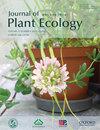Change in seed dormancy status controls seasonal timing of seed germination in Pinus koraiensis Sieb. et Zucc
IF 3.9
2区 环境科学与生态学
Q2 ECOLOGY
引用次数: 1
Abstract
Seed dormancy ensures seedling will establish in the favorable season in a seasonally changing environment. Korean pine seeds have morphophysiological dormancy after dispersal in autumn. A small fraction of seeds germinates in the first spring, but most seeds germinate in the second spring following dispersal. It is not clear how dormancy status changes and thus drives germination characteristic. Fresh Korean pine seeds were buried between litterfall and soil in Fenglin National Nature Reserves, Heilongjiang province, Northeastern China, in middle October 2018 and regularly exhumed. Field germination percentage, embryo growth, seed viability and laboratory germination percentage of exhumed seeds were determined. The physiological dormancy part of morphophysiological dormancy was gradually released during the first winter, but re-induced in the first summer following dispersal. The re-induced physiological dormancy was broken again in the second autumn and winter. The morphological dormancy part of morphophysiological dormancy was slowly released over the first summer but rapidly broken during the second early and middle autumn. In the second spring, Korean pine seeds completely escaped from morphophysiological dormancy. The physiological dormancy part of morphophysiological dormancy was completely released, but the morphological dormancy part was still maintained, leading to very low germination in the first spring in the field. Relief of morphophysiological dormancy enables a high percentage of seeds to germinate at relatively low temperature (alternating day/night temperature above 10/5°C) in the second spring. Korean pine provides an example of the change in dormancy status of seeds with morphophysiological dormancy.种子休眠状态的变化控制着红松种子萌发的季节性时间。et Zucc
种子休眠确保幼苗在季节变化的环境中在有利的季节建立。红松种子在秋季扩散后具有形态生理休眠。一小部分种子在第一个春天发芽,但大多数种子在分散后的第二个春天发芽。目前尚不清楚休眠状态是如何变化的,从而驱动发芽特性。2018年10月中旬,新鲜的红松种子被埋葬在中国东北黑龙江省枫林国家级自然保护区的落叶和土壤之间,并定期被挖掘出来。测定了挖出种子的田间发芽率、胚胎生长、种子活力和实验室发芽率。形态生理休眠的生理休眠部分在第一个冬季逐渐释放,但在扩散后的第一个夏季重新诱导。再次诱导的生理休眠在第二个秋冬季再次被打破。形态生理休眠的形态休眠部分在第一个夏季缓慢释放,但在第二个早中秋迅速打破。第二年春天,红松种子完全脱离了形态生理休眠。形态生理休眠的生理休眠部分被完全释放,但形态休眠部分仍然保持,导致田间初春发芽率很低。形态生理休眠的解除使高比例的种子能够在第二个春天在相对较低的温度(高于10/5°C的昼夜交替温度)下发芽。红松提供了一个具有形态生理休眠的种子休眠状态变化的例子。
本文章由计算机程序翻译,如有差异,请以英文原文为准。
求助全文
约1分钟内获得全文
求助全文
来源期刊

Journal of Plant Ecology
生物-植物科学
CiteScore
4.60
自引率
18.50%
发文量
134
审稿时长
3 months
期刊介绍:
Journal of Plant Ecology (JPE) serves as an important medium for ecologists to present research findings and discuss challenging issues in the broad field of plants and their interactions with biotic and abiotic environment. The JPE will cover all aspects of plant ecology, including plant ecophysiology, population ecology, community ecology, ecosystem ecology and landscape ecology as well as conservation ecology, evolutionary ecology, and theoretical ecology.
 求助内容:
求助内容: 应助结果提醒方式:
应助结果提醒方式:


